Ancient Korean Architecture › Heian Period » Ancient origins
Articles and Definitions › Contents
- Ancient Korean Architecture › Ancient History
- Heian Period › Ancient History
Ancient civilizations › Historical and archaeological sites
Ancient Korean Architecture › Ancient History
Definition and Origins

The architecture of ancient Korea is epitomised by the artful combination of wood and stone to create elegant and spacious multi-roomed structures characterised by clay tile roofing, enclosures within protective walls, interior courtyards and gardens, and the whole placed upon a raised platform, typically of packed earth. The immediate topography of buildings was also important as architects endeavoured to harmoniously blend their designs into the natural environment and take advantage of scenic views. The work of Korean architects is also seen in fortification walls and tombs across the peninsula ranging from Bronze Age dolmens to the huge vaulted enclosures of ancient Korean kings.
The architecture of ancient Korea (in this article the period prior to c. 1230 CE) is best described in relation to the three most distinct periods of Korean history within our timeframe: the Three Kingdoms period from the 4th to 7th century CE when the Silla, Goguryeo ( Koguryo ), and Baekje ( Paekche ) dynasties ruled the peninsula; the Unified Silla Kingdom, which ruled from 668 to 935 CE; and the Goryeo (Koryŏ) Dynasty which ruled from 918 to 1392 CE. Before covering these periods, though, Prehistoric Korea does provide some interesting examples of monumental architecture in the form of dolmen tombs.
PREHISTORIC KOREA
Bronze Age Korean villages were characterised by small semi-subterranean houses built into hillsides. They were either circular or square in design, dug 1.5 metres into the ground, and had thatched roofs. They typically had several hearths and were sometimes protected by wooden fencing. An example of such a village is Hunam-ri near the Han River which has 14 houses and dates to c. 1200 BCE.
THE TOPOGRAPHY WAS CONSIDERED AN IMPORTANT FACTOR WHICH COULD INFLUENCE THE DESIGN OF A BUILDING SO THAT IT BLENDED INTO ITS LOCAL SURROUNDINGS.
Dolmens (in Korean: ko'indol or chisongmyo ) - simple structures made of monolithic stones - appear most often near villages, and the archaeological finds buried within them imply that they were constructed as tombs for elite members of the community.200,000 are known in Korea (with 90% of them in South Korea). They take three forms: the 'table' form where one large stone rests horizontal on two upright stones, one large flat stone set on top of a mound of smaller stones, and a single large stone laid flat above a small buried tomb lined with stone slabs. The first type most often occurs in isolation while the others are sometimes found set in rows or groups. Outstanding examples of ancient Korean dolmens are the table-type structures on Ganghwa Island which date to c. 1000 BCE in the Korean Bronze Age. Single standing stones (menhirs), unrelated to a burialcontext and perhaps used as marker stones, are also found across Korea.
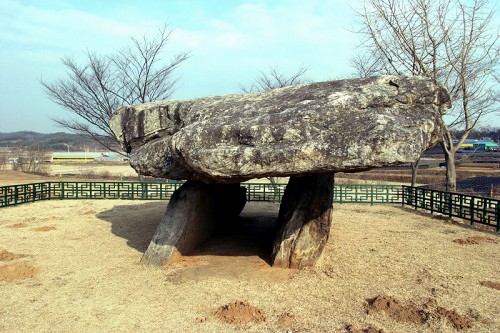
Table Dolmen, Ganghwa, Korea
THE THREE KINGDOMS (4TH-7TH CENTURY CE)
Goguryeo
Unfortunately, there are few surviving public buildings from ancient Korea and no palaces prior to the 16th century CE.However, archaeology and surviving tombs and their wall -paintings have permitted historians to identify the principal characteristics of palace and temple architecture throughout our period. Three Goguryeo-period Buddhist temples have been excavated at Pyongyang, but there are few remains except indications that one had an octagonal pagoda in the centre.
Some of the more substantial surviving archaeological remains from the Goguryeo towns are walls and fortifications from Tonggou, Fushun, and Pyongyang. Tonggou had 8 km of stone wall around the town while Fushun had 2.3 km of wall, which included four gates. Pyongyang, one-time Goguryeo capital, had very large buildings measuring up to 80 x 30 m and palaces with gardens which had artificial hills and lakes. Buildings were decorated with impressed roof tiles carrying lotus flower and demon mask designs which are found in abundance at the sites. In 552 CE a new town was built nearby on the Taesongsan hill with 7 km of fortification walls which had 20 gates and towers as well as various storehouses and wells incorporated into it.
Better survivors than external buildings are tombs, and the earliest Goguryeo ones took the form of stone cairns using river cobbles. However, by the 4th century CE, square tombs were placed within pyramids made of cut-stone blocks. The largest example is at the former capital Kungnaesong (modern Tonggou) and thought to be that of King Gwanggaeto the Great (r. 391–412 CE). 75 metres long and using blocks measuring 3 x 5 metres, it also has four smaller dolmen-like structures at each corner.
Another important tomb is that of Tong Shou, last ruler of Taebang. Located near Pyongyang, an inscription dates the tomb to 357 CE. Its central chamber has 18 limestone columns and wall-paintings; it is surrounded by four smaller chambers. More typical, though, of Goguryeo-period tombs than these two examples are more modest hemispherical earth mounds built over a square base and with an interior tomb of stone. Other architectural features seen in various Goguryeo tombs include corbelled roofing, octagonal pillars, and pivoted stone doors.
Baekje
The art and architecture of the Baekje kingdom are generally considered the finest of the three Kingdoms but, unfortunately for posterity, these have also suffered the greatest destruction thanks to warfare with the Silla, Goguryeo, and Chinese Tangdynasties over the centuries.
The Miruk temple at Iksan had two stone pagodas and one in wood. One stone pagoda survives, albeit with only six of its original 7-9 storeys. The only other surviving Baekje pagoda is also of stone and located at the Chongnim temple at Puyo.Finally, elements of Baekje architectural design can be seen in many surviving wooden buildings in Japan as many Baekje craftsmen went there when Wa Japan was an ally.
Perhaps one of the most impressive tombs from the Baekje kingdom in this period is that of King Muryeong-Wang (r. 501–523 CE) which, within its huge earth mound, has a semi-circular vault lined with hundreds of moulded bricks, many decorated with lotus flower and geometric designs. The structure, located near Gongju, dates to 525 CE, as indicated by an inscription plaque within the tomb.
Silla
Typical Silla tombs of this period are composed of a wooden chamber set in an earth pit which was then covered with a large pile of stones and a mound of earth. To make the tomb waterproof, layers of clay were applied between the stones. Many tombs contain multiple burials, sometimes as many as ten individuals. The lack of an entrance has meant that many more Silla tombs have survived intact in respect to the other two kingdoms and so provided treasures from golden crowns to jade jewellery. The largest such tomb, actually composed of two mounds and containing a king and queen, is the Hwangnam Taechong tomb. Dating to the 5-7th century CE, the tomb measures 80 x 120 m, and its mounds are 22 and 23 m high.
At Gyeongju (Kyongju), the Silla capital has the unique mid-7th century CE Cheomseongdae observatory. 9 metres tall, it acted like a sundial but also has a south-facing window which captures the sun's rays on the interior floor on each equinox. It is the oldest surviving observatory in East Asia.
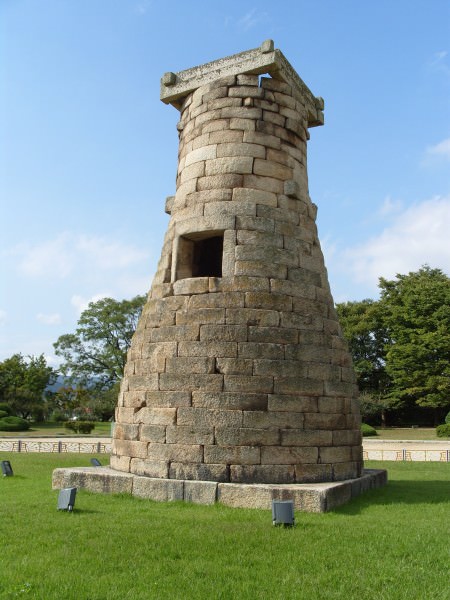
Cheomseongdae Observatory, Gyeongju
UNIFIED SILLA KINGDOM (668-935 CE)
The capital of Gyeongju became even more splendid in this period and is described in the Samgungnyusa collection of texts as having an astonishing 35 palaces, 55 streets, 1360 districts, and 178,936 houses. The palaces had their own gardens and lakes, but all that survives of the buildings themselves are decorative floor tiles. Notable surviving structures at the capital include two surviving stone pagodas – the Dabotap and Seokgatap – which both date to the 8th century CE, traditionally 751 CE. Stone pagodas are Korea's unique contribution to Buddhist architecture, and this pair were originally part of the magnificent 5th-7th century CE Bulguksa temple (Temple of the Buddha Land) which now stands restored but only a fraction of its original size.
One of the outstanding stone structures from the Unified Silla period is the Buddhist Seokguram Grotto (Sokkuram) temple east of Gyeongju. Constructed between 751 and 774 CE, it contains a circular domed inner chamber within which is a massive seated Buddha. The walls are decorated with 41 figure sculptures set in niches.
From the 7th century CE, Silla tombs became more like the earlier tombs of the Goguryeo and Baekje with a smaller earth mound on top, which was then faced with stone slabs. The slabs are frequently decorated with relief carvings of the twelve animals of the oriental zodiac. Each figure carries a weapon and so offers symbolic protection of the tomb. Two of the finest examples are the tombs of the general Kim Yu-sin (7th century CE) and King Wonseong (8th century CE) at Kwaerung.
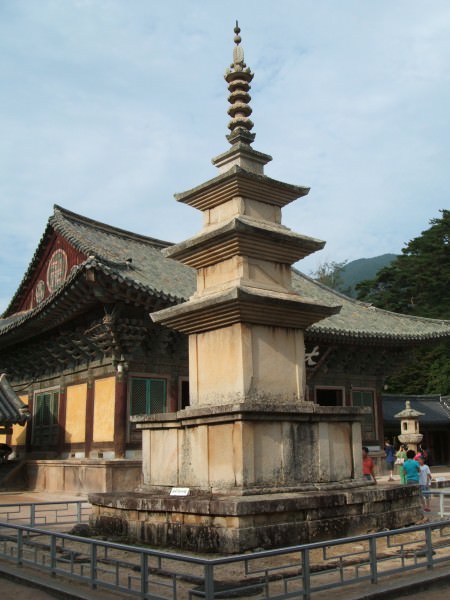
Seokgatap Pagoda, Gyeongju
GORYEO DYNASTY (918-1392 CE)
As already noted, there are no surviving temples from the Goryeo dynasty, made as they were largely of wood, which is a poor archaeological survivor. A good idea of the architectural style is seen in the 13th-century CE Hall of Eternal Life (Muryangsujeon) at the Pusok temple in Yongju. It is one of the oldest wooden structures surviving in the whole of Korea. Its roof displays a dual edge and is supported by three-tiered supports. It also has the more complex roof brackets at the top of supporting columns typical of the period. The wooden columns taper and permit ceilingless openwork. Stone pagodas have survived better, and these are eclectic depending on location. Some continue the style of earlier periods while others have an octagonal or pentagonal form (influenced by Song China ) or a more bulbous shape, perhaps imitating the flat round discs seen in Shamanistic art. Stone lanterns are another indicator of Goryeo architectural design. Many take the form of pairs of lions, columns, or octagonal platforms.
The best-preserved tomb from the Goryeo period is beyond our time frame but, nevertheless, deserves mention and, in any case, continues the architectural traditions of the whole period. Located near Kaesong, it is that of king Kongmin (r. 1330-1374 CE) and his Mongolian wife Noguk. The two mounds of the tomb have stone balustrades with statues of tigers and sheep, which represent yin and yang. Within the mound are two stone chambers decorated with wall-paintings and constellations on the ceilings. 11th and 12th century CE tombs are also to be found at Kaesong and are similarly decorated, the animal zodiac occurring in several as it does in Kongmin's tomb.
ARCHITECTURAL THEMES
Having considered this long history of architectural development, we can now summarise some of the basic elements and features common to most traditional buildings in ancient Korea. The first decision to be made by Korean architects was where exactly to build their structures. The topography was considered an important factor which could influence the design of a building so that it blended into its local surroundings ( pungsu ). The best possible place was a site backed by mountains to block the wind and opening onto a wide plain with a river running through it. Both features were thought to provide energy or giwhich would flow into the building. Such a location was described as baesan imsu. Also important was to have a pleasant view, the andae, which meant that not only single buildings but sometimes entire villages faced a particular direction.

Korean Hanok Architecture
Construction began with the timber columns (pine was preferred) of the building but these were very often set not directly on the ground but on large stones gathered locally. The use of these stones represented an immediate harmony between the artificial structure and nature, so much so that the stones were not cut but rather the bottom of the wooden column was carved so as to fit exactly over the rough stone. This process is called deombeong jucho. Columns could be round, square, hexagonal or octagonal, although round columns were generally reserved for more important buildings. As in ancient Greek architecture columns were purposely made thinner at the base, thicker in the middle and taller at the corners of the building to make them appear truly straight from a distance, an art known as baeheullim. An additional strategy was to have all the columns lean slightly inwards, a feature called ansollim.
Once the supporting columns were in place, then the rest of the structure was built using wooden beams carefully selected for their strength and with their natural curvature maintained. The Daeungjeon (Main Hall) building at the Cheonynyongsa temple is an excellent example of this approach. Walls were made with earth packed into moulds and about 40 cm thick, or with mud applied to a bamboo framework. Mud was made stronger by mixing in straw and sometimes made waterproof by adding water which had been boiled with seaweed. Windows were made using wooden slats.
Roofs of Korean buildings are typically high-pitched to allow easy drainage of rainwater, which can be heavy in the monsoon season, and strong enough to resist the weight of snow in winter. They are also high to permit air-flow in the warmer months.Ancient roofs were made of wooden beams and then tiled ( giwa ) over a layer of earth to provide extra insulation. The roofs are concave for aesthetic purposes and the eaves also gently curve upwards ( cheoma ). This curvature permits extra sunlight in winter to enter the building and at the same time provide a little extra shade in summer.
Finally, many public buildings were enclosed within a wall which carried a small tile roof. The entrance was formed by a tiled-roof gate, sometimes taller than the wall ( soseuldaemun ) or level with it ( pyeongdaemun ). The most important temples and palaces often had a triple gate or sammun. Tomb sites usually have a simpler gate ( hongsalmun ) made of two red columns supporting a row of vertical red beams.
KOREAN PRIVATE RESIDENCES - THE HANOK
A traditional Korean private home ( hanok ), or at least those of the upper classes, employed much the same materials as larger Korean public buildings and had similar roofing, but on a smaller scale. The most important structures were, again, timber supporting columns, which defined room space. Between these columns, the external walls were constructed using brick, stone, or earth. Interior walls or temporary room divisions were made using plain sliding paper doors ( changhoji ) made from mulberry bark. In Korea, only public buildings such as temples, administrative offices, and palaces were permitted to carry colourful wall decoration. External doors and windows were made using interlocking grids of wood ( changsal ), often carved into highly decorative latticework ( kkotsal ). The roof was built using wooden beams and then tiled using clay tiles.Roofs could either be in the form of a gable or have overhanging eaves as in public buildings.

Hanok Interior
A single home often enclosed several inner courtyards and sometimes a garden. There was a separation of living areas for males, females, and servants. Rooms were also divided into functional areas such as hosting guests, sleeping quarters, food preparation, storage, and space for domestic animals. The floors of rooms could be either in wood and slightly elevated (the maru system) to keep the room cool in hot months or used the ondol system of underfloor heating necessary for winter months. This latter type, made of stone with a waxed paper covering, has a system of flues through which hot air flows from the main hearth of the house. It was first employed in the 7th century CE and widely used throughout Korea. Those rooms which were heated in this way had lower paper ceilings while unheated rooms reached the bare roof timbers.
More modest homes for the peasantry were, of course, much simpler affairs than these larger residences having only a few rooms and roofed with thatch ( choga ), most often using rice straw, laid over a layer of earth spread over wooden boards.Indeed, the presence of roof tiles almost certainly became a status symbol and they were only permitted on the residences of individuals of rank in ancient Korean society.
[bks]
Heian Period › Ancient History
Definition and Origins

The Heian Period of Japanese history covers 794 to 1185 CE and saw a great flourishing in Japanese culture from literatureto paintings. Government and its administration came to be dominated by the Fujiwara clan who eventually were challenged by the Minamoto and Taira clans. The period, named after the capital Heiankyo, closes with the Genpei War in which the Minamoto were victorious and their leader Yoritomo established the Kamakura Shogunate.
FROM NARA TO HEIANKYO
During the Nara Period (710-794 CE) the Japanese imperial court was beset by internal conflicts motivated by the aristocracy battling each other for favours and positions and an excessive influence on policy from Buddhist sects whose temples were dotted around the capital. Eventually, the situation resulted in Emperor Kammu (r. 781-806 CE) moving the capital from Nara to (briefly) Nagaokakyo and then to Heiankyo in 794 CE to start afresh and release the government from corruption and Buddhist influence. This marked the beginning of the Heian Period which would last into the 12th century CE.
The new capital, Heiankyo, meaning 'the capital of peace and tranquillity,' was laid out on a regular grid plan. The city had a wide central avenue which dissected the eastern and western quarters. Architecture followed Chinese models with most buildings for public administration having crimson columns supporting green tiled roofs. Private homes were much more modest and had thatch or bark roofs. The aristocracy had palaces with their own carefully landscaped gardens and a large pleasure park was built south of the royal palace (Daidairi). No Buddhist temples were permitted in the central part of the city and artisan quarters developed with workshops for artists, metal workers and potters.
KYOTO WOULD REMAIN THE CAPITAL OF JAPAN FOR A THOUSAND YEARS.
No Heian Period buildings survive today from the capital except the Shishin-den (Audience Hall) which was burnt down but faithfully reconstructed and the Daigoku-den (Hall of State) which suffered a similar fate and was rebuilt on a smaller scale at the Heian Shrine. From the 11th century CE the city's longtime informal name meaning simply 'the capital city' was officially adopted: Kyoto. It would remain the capital of Japan for a thousand years.
HEIAN GOVERNMENT
Kyoto was the centre of a government which consisted of the emperor, his high ministers, a council of state and eight ministries which, with the help of an extensive bureaucracy, ruled over some 7,000,000 people spread over 68 provinces, each ruled by a regional governor and further divided into eight or nine districts. In wider Japan, the lot of the peasantry was not quite so rosy as the aesthetics-preoccupied nobility at court. The vast majority of Japan's population worked the land, either for themselves or the estates of others, and they were burdened by banditry and excessive taxation. Rebellions such as occurred in Kanto under the leadership of Taira no Masakado between 935 and 940 CE were not uncommon.

Model of Kyoto
The policy of distributing public lands which had been instigated in previous centuries came to an end by the 10th century CE, and the result was that the proportion of land held in private hands gradually increased. By the 12th century CE 50% of land was held in private estates ( shoen ) and many of these, given special dispensation through favours or due to religious reasons, were exempt from paying tax. This situation would cause a serious dent in the state's finances. Wealthy landowners were able to reclaim new land and develop it, thus increasing their wealth and opening an ever wider gap between the haves and have-nots. There were also practical political repercussions as the large estate owners became more remote from the land they owned, many of them actually residing at court in Heiankyo. This meant that estates were managed by subordinates who sought to increase their own power, and conversely, the nobility and the emperor became more separated from everyday life. Most commoners' contact with the central authority was limited to paying the local tax collector and brushes with the metropolitan police force which not only maintained public order but also tried and sentenced criminals.
MANY FUJIWARA STATESMEN WOULD ACT AS REGENT FOR THREE OR FOUR EMPERORS DURING THEIR CAREER.
The dominance of the Fujiwara was not total and did not go unchallenged. Emperor Shirakawa (r. 1073-1087 CE) attempted to assert his independence from the Fujiwara by abdicating in 1087 CE and allowing his son Horikawa to reign under his supervision. This strategy of 'retired' emperors, still in effect governing, became known as 'cloistered government' ( insei ) as the emperor usually remained behind closed doors in a monastery. It added another wheel to the already complex machine of government.
Back in the provinces, new power-brokers were emerging. Left to their own devices and fuelled by blood from the minor nobility produced by the process of dynastic shedding (when an emperor or aristocrat had too many children they were removed from the line of inheritance), two important groups evolved, the Minamoto (aka Genji) and Taira (aka Heike) clans.With their own private armies of samurai, they became important instruments in the hands of rival members of the Fujiwara clan's internal power struggle which broke out in the 1156 CE Hogen Disturbance and the 1160 CE Heiji Disturbance.
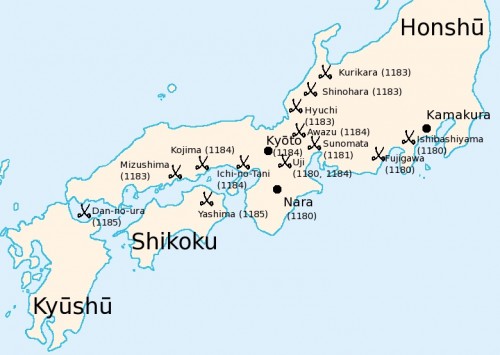
Battles of the Genpei War
The Taira, led by Taira no Kiyomori, eventually swept away all rivals and dominated government for two decades. However, in the Genpei War (1180-1185), the Minamoto returned victorious, and at the war's finale, the Battle of Dannoura, the Taira leader, Tomamori, and the young emperor Antoku committed suicide. The Minamoto clan leader Yoritomo was shortly after given the title of shogun by the emperor and his rule would usher in the Kamakura Period (1185-1333 CE), also known as the Kamakura Shogunate, when Japanese government became dominated by the military.
HEIAN RELIGION
In terms of religion, Buddhism continued its dominance, helped by such noted scholar monks as Kukai (774-835 CE) and Saicho (767-822 CE), who founded the Shingon and Tendai Buddhist sects respectively. They brought from their visits to China new ideas, practices, and texts, notably the Lotus Sutra ( Hokke-kyo ) which contained the new message that there were many different but equally valid ways to enlightenment. There was also Amida (Amitabha), the Buddha of Pure Land Buddhism, who could help his followers on this difficult path.
Buddhism's spread was assisted by government patronage, although, the emperor was wary of undue power amongst the Buddhist clergy and so took to appointing abbots and confining monks to their monasteries. Buddhist sects had become powerful political entities and although monks were forbidden from carrying weapons and killing, they could pay novice monks and mercenaries to do their fighting for them to win power and influence in the mishmash of nobles, landed-estate managers, private and imperial armies, emperor and ex-emperors, pirates, and warring clans that plagued the Heian political landscape.
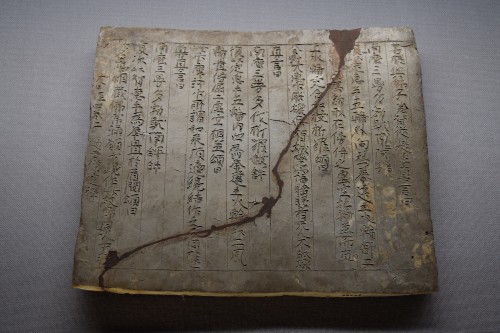
Sutra Inscribed Tablet
Confucian and Taoist principles also continued to be influential in the centralised administration, and the old Shinto and animist beliefs continued, as before, to hold sway over the general populace while Shinto temples such as the Ise Grande Shrine remained important places of pilgrimage. All of these faiths were practised side by side, very often by the same individuals, from the emperor to the humblest farmer.
RELATIONS WITH CHINA
Following a final embassy to the Tang court in 838 CE, there were no longer formal diplomatic relations with China as Japan became somewhat isolationist without any necessity to defend its borders or embark on territorial conquest. However, sporadic trade and cultural exchanges continued with China, as before. Goods imported from China included medicines, worked silk fabrics, ceramics, weapons, armour, and musical instruments, while Japan sent in return pearls, gold dust, amber, raw silk, and gilt lacquerware.
Monks, scholars, musicians, and artists were sent to see what they could learn from the more advanced culture of China and bring back new ideas on anything from painting to medicine. Students also went, many spending several years studying Chinese administrative practices and bringing back their knowledge to the court. Books came too, a catalogue dating to 891 CE lists more than 1,700 Chinese titles made available in Japan which cover history, poetry, court protocols, medicine, laws, and Confucian classics. Still, despite these exchanges, the lack of regular missions between the two states from the 10th century CE meant that the Heian Period overall saw a diminishing in the influence of Chinese culture, which meant that Japanese culture began to find its own unique path of development.
HEIAN CULTURE
The Heian period is noted for its cultural achievements, at least at the imperial court. These include the creation of a Japanese writing ( kana ) using Chinese characters, mostly phonetically, which permitted the production of the world's first novel, the Tale of Genji by Murasaki Shikibu (c. 1020 CE), and several noted diaries ( nikki ) written by court ladies, including The Pillow Book by Sei Shonagon which she completed c. 1002 CE. Other famous works of the period are the Izumi Shikibu Diary, Fujiwara no Michitsuna's Kagero nikki , and a Tale of Flowering Fortunes by Akazome Emon.
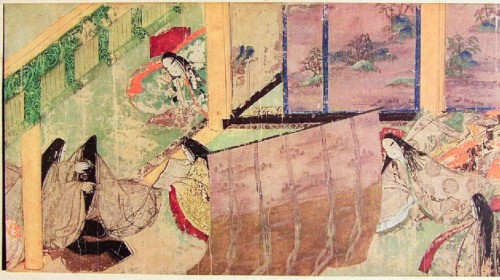
Tale of Genji Illustration
Men did write poetry, though, and the first anthology of royally commissioned Japanese poems, the Kokinshu ('Collection of the Past and Present') appeared in 905 CE. It was a collection of poems by men and women and was compiled by Ki no Tsurayuki, who famously stated, "The seeds of Japanese poetry lie in the human heart" (Ebrey, 199).
Besides literature, the period also saw the production of especially fine clothing at the royal court, using silk and Chinese brocades. Visual arts were represented by screen paintings, intricate hand scrolls of pictures and text ( e-maki ), and fine calligraphy. An aristocrat's reputation was built not only on his position at court or in the administration but also his appreciation of these things and his ability to compose his own poetry, play music, dance, master board games like go, and perform feats of archery.
Painters and sculptors continued to use Buddhism as their inspiration to produce wooden sculptures (painted or left natural), paintings of scholars, gilded bronze bells, rock-cut sculptures of Buddha, ornate bronze mirrors, and lacquered cases for sutras which all helped spread the new sects' imagery around Japan. Such was the demand for art that for the first time a class of professional artists arose, the work previously having been created by scholar monks. Painting also became a fashionable pastime for the aristocracy.
Gradually, a more wholly-Japanese approach expanded the range of subject matter in art. A Japanese style, Yamato-e, developed in painting particularly, which distinguished it from Chinese works. It is characterised by more angular lines, the use of brighter colours, and greater decorative details. Lifelike portraits of court personalities such as those by Fujiwara Takanobu, illustrations inspired by Japanese literature, and landscapes became popular, paving the way for the great works to come in the medieval period.
This article was made possible with generous support from the Great Britain Sasakawa Foundation.
LICENSE:
Article based on information obtained from these sources:with permission from the Website Ancient History Encyclopedia
Content is available under License Creative Commons: Attribution-NonCommercial-ShareAlike 3.0 Unported. CC-BY-NC-SA License